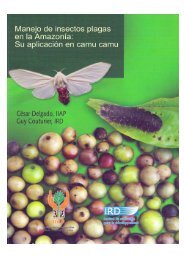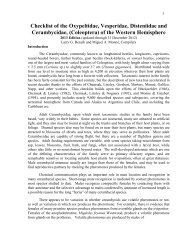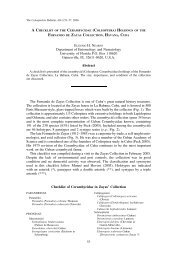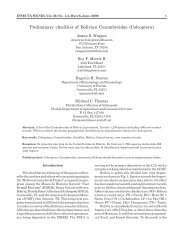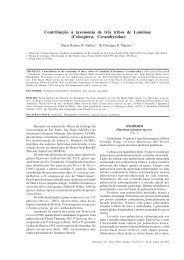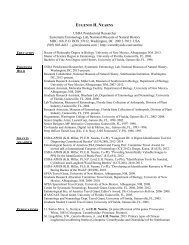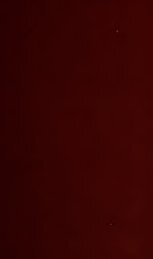Preliminary Checklist of Bolivian Cerambycidae (Coleoptera) - II ...
Preliminary Checklist of Bolivian Cerambycidae (Coleoptera) - II ...
Preliminary Checklist of Bolivian Cerambycidae (Coleoptera) - II ...
You also want an ePaper? Increase the reach of your titles
YUMPU automatically turns print PDFs into web optimized ePapers that Google loves.
= Bolivia (country record only); PN = Pando; BN = Beni; SC = Santa Cruz; CO = Cochabamba; LP =<br />
LaPaz; OR = Oruro; PT = Potosi: CQ = Chuquisaca; TR = Tarija.<br />
Bolivia is a landlocked country in central South America <strong>of</strong> 1,098,579 sq km, or about three times<br />
the area <strong>of</strong> Montana. It exhibits tremendous geographical, floral, and faunal diversity. To the north is<br />
the southern extension <strong>of</strong> the Amazon Basin, with extensive lowland rain forests and savanahs (llanos);<br />
to the southeast are dry scrub and thorn forests (chaco). Cloud forests (yungas) cloak the shoulders <strong>of</strong><br />
the Andes, which dominate the southwestern third <strong>of</strong> the country. Above the yungas are wet grasslands<br />
called the puna. Between the two ridges <strong>of</strong> the Andes lies the altiplano, a high, dry plateau. Where these<br />
different habitats meet and intergrade can be areas <strong>of</strong> dramatic faunal and floral diversity, such as in<br />
the western part <strong>of</strong> the Department <strong>of</strong> Santa Cruz. For example, Amboró Protected Area, in which 830<br />
species <strong>of</strong> birds have been recorded, contains 11 Holdridge Life Zones, the same as the entire country<br />
<strong>of</strong> Costa Rica (Clarke Gemuseus and Sagot 1996). Similar numbers <strong>of</strong> cerambycid species have been<br />
collected nearby in the vicinity <strong>of</strong> Buena Vista.<br />
The checklist includes higher taxonomic classifications and now follows the arrangement <strong>of</strong> Monné<br />
and Hovore 2005. Within Subfamilies tribes are listed alphabetically as are the genera within the tribes<br />
and the species within the genera. In the original checklist new taxa were shown in Bold type. This<br />
has been eliminated from the 2007 list.<br />
Discussion<br />
The original checklist, published in 2006 (Insecta Mundi 20(1-2) included 1,259 cerambycid species<br />
with 496 (40 per cent) newly recorded for Bolivia. It also recorded 67 tribes and 501 genera. This has<br />
now grown to 1,332 species, 74 tribes and 523 genera. Among the nine cerambycid subfamilies in the<br />
western hemisphere all but Asemiinae and Spondylinae are recorded from Bolivia. Almost 80 per cent<br />
<strong>of</strong> the species are recorded from Santa Cruz Department. To a great extent this reflects the diverse<br />
biogeography <strong>of</strong> Santa Cruz however, it also reflects collecting bias by the authors and others. Although<br />
not included in the checklist, almost 400 additional, but as yet undetermined, species have been<br />
collected by project participants. About one-third <strong>of</strong> these are Acanthocinines with the remainder<br />
scattered across 40 additional tribes. The scarcity <strong>of</strong> collections from departments other than Santa<br />
Cruz and the amount <strong>of</strong> undetermined material on hand continues to explain the "preliminary" nature<br />
<strong>of</strong> the checklist.<br />
Acknowledgements<br />
The authors wish to acknowledge and thank the numerous individuals and institutions who have<br />
contributed to this checklist. We are especially grateful to our <strong>Bolivian</strong> cooperators Julieta Ledezma<br />
Arias, Chief, Department <strong>of</strong> Entomology, and Jose Luis Aramayo, Research Associate, Museo de<br />
Historia Natural “Noel Kempff Mercado,” Santa Cruz de la Sierra, Bolivia for authorizing and<br />
supporting our activities in Bolivia. For access to institutional collections in their care we are indebted<br />
to: Jaime Sarmiento, Coleccion <strong>Bolivian</strong>a de Fauna del Museo de Historia Natural, La Paz, Bolivia;<br />
Julieta Ledezma Arias, Museo de Historia Natural “Noel Kempff Mercado”, Santa Cruz de la Sierra,<br />
Bolivia; John Rawlins, Robert Davis, and Bob Androw, Carnegie Museum, Pittsburg, PA.; Steven<br />
Lingafelter, US Natural History Museum, Washington, DC; Paul Skelley, Florida State Collection <strong>of</strong><br />
Arthropods, Gainesville, FL; Ubirajara Martins, Museu de Zoologia, Universidade de Sao Paulo, Sao<br />
Paulo, Brazil and Miguel Monné, Museu Nacional, Universidade Federal do Rio de Janeiro, Rio de<br />
Janeiro, Brazil. We also greatly appreciate the following participants in the <strong>Bolivian</strong> Cerambycid Project<br />
and for their sharing collected specimens and data: Robin Clarke, Andrew Cline, Byrd Dozier, Charyn<br />
Micheli, and Norm Woodley. For the loan <strong>of</strong> specimens or supplying data from their cerambycid<br />
collections we thank Fray Andres Langer, Joe Eger, Martin Hauser, Stewart Peck, Patrick Sullivan and<br />
Bryan Eya.<br />
2



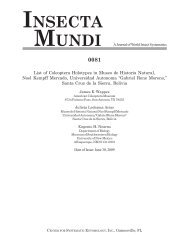
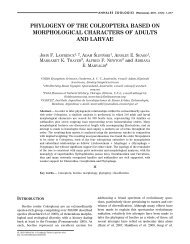


![Coleoptera. Vol. I. [Longicornia. Part I.]](https://img.yumpu.com/41202793/1/180x260/coleoptera-vol-i-longicornia-part-i.jpg?quality=85)
